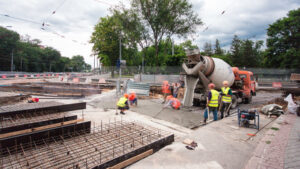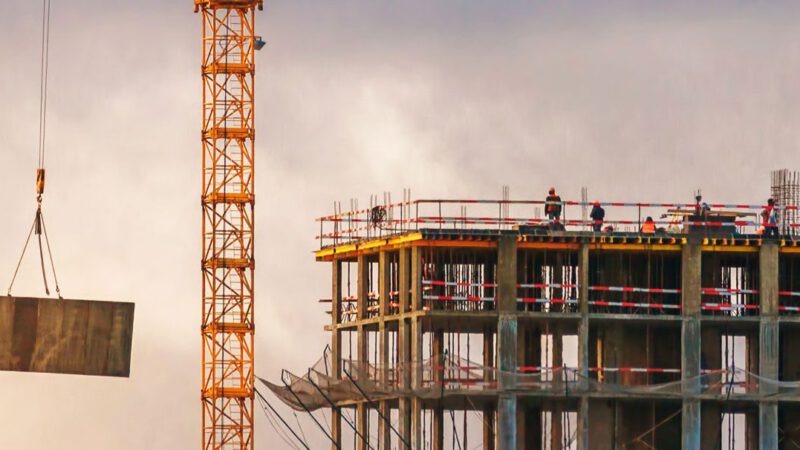Steps Involved In The Concrete Construction Process
Concrete is a great construction material that is strong, durable, and versatile. It is also relatively safe to work with, as long as proper safety precautions are taken.
The first step is to mix the concrete. This can be done by hand or with a machine. The ingredients are measured by either volume or weight and mixed to form the design mix. If you’re thinking of hiring a professional, call Concrete Contractors Colorado Springs today.
 Preparation
Preparation
Concrete is one of the most common building materials on earth. It can be made from a variety of materials but is often a combination of aggregate, cement, sand, gravel, and water. It is used for a wide variety of construction projects due to its cost-effectiveness and durability. Its longevity means lower maintenance and insurance costs compared to other materials such as steel and wood.
The concrete construction process begins with the preparation of the surface of the project site. This is done to remove any contaminated, damaged, or failing layers that could cause issues with the new layers and coatings to be applied. This step is also important to ensure the integrity of the concrete that will be built, ensuring it can withstand the required loads and stresses.
Depending on the job requirements, the level of concrete surface preparation needed can vary. For example, surfaces that will receive a concrete overlay or resurfacing treatment require a more aggressive level of preparation than those that are only going to be coated with sealers or stains. For this reason, contractors need to have a variety of surface preparation tools at their disposal.
This includes dry and wet grinding, vacuum blasting, abrasive brushing, needle scaling, scabbling, and rotomilling. The specific method used on a given surface will depend on how contaminated or damaged it is, as well as how much of an impact the concrete surface will experience as a result of the preparation process.
The strength of concrete is a direct correlation to the amount of moisture it contains. This is why concrete must be kept damp for some time after it has been poured. This prevents the concrete from drying too quickly, which would reduce its compressive strength. It is also critical to ensure the proper temperature is maintained during curing to avoid reducing its tensile strength.
It is possible to improve the strength of concrete by adding pre-tensioned metal wires, rods, or cables. This is particularly useful in areas where a high degree of tensile stress is expected, such as in the middle of long unsupported spans of roofs or bridges.
Mixing
During mixing, the ingredients of concrete are mixed thoroughly to create a uniform mix. The mix is then poured into the formwork or mold to create a solid structure. Various methods are used to mix concrete, and each method has its benefits and drawbacks. The mix must be consistent with design specifications so that the final concrete has a high level of strength and durability.
Machine mixing is a highly effective method for achieving a short mixing time and an optimum consistency of concrete. Concrete mixers are available in a wide range of models, from small portable types to large stationary units. Some of these mixers are designed to be batched, while others are continuous. The location of the construction site, type and constituents of the concrete mix, construction schedule, and cost all factor into which type of mixer is most appropriate.
One method of evaluating a mixer is to measure the workability of the concrete at different times during the mixing process. This can be done using a device called a rheometer, which measures the stress generated by the concrete as it is being mixed. Another way to evaluate a mixer is by measuring the power consumption of the motor during the mixing process.
The order in which the constituents are loaded into the mixer also has a significant effect on concrete properties. The order of loading must be carefully chosen to ensure that it does not decrease the quality of the finished product. For example, it is important to load the pozzolanic materials in before the water to avoid segregation.
In the past, concrete specifications prescribed fixed proportions of cement, and fine and coarse aggregates. These are known as nominal mixes and, under normal conditions, provide adequate strength for the intended use. However, variations in the quality of the individual components and the mixing process lead to a range of nominal concrete strengths.
When making a concrete mixture, the cement paste coats and binds the aggregates, providing a rock-solid structure that is capable of withstanding heavy loads. The grade of the concrete is determined by its compressive strength, which is expressed in MPa and is denoted by a letter such as M30.
Pouring
Concrete is a composite material made from a mixture of cement and aggregates such as sand or gravel. A small amount of water is also added to the mix. When mixed properly the cement and water will start to react with each other creating a hard rock-like substance known as concrete. Concrete is an extremely durable construction material that is used for a wide variety of applications. It is highly resistant to abrasion, corrosion, and chemicals. In addition, it is strong enough to support the weight of heavy machinery and equipment. Concrete can be molded into different shapes, making it a versatile building material that can be used for a variety of projects.
Concrete can last for centuries, even under the most extreme conditions. It is one of the most cost-effective building materials available and can withstand almost any type of weather. It is also fireproof and very insulating. This helps to reduce the energy costs of a building by keeping it cool in summer and warm in winter.
The process of constructing concrete is very labor-intensive and requires the use of many tools. The main steps in the process include the estimation of materials, site preparation, building formwork, mixing, pouring, and finishing. Various types of additives can be added to the concrete during the mixing phase to improve its performance. The final stage involves curing the concrete.
While concrete is often thought of as a solid mass that cannot be easily shaped, it is quite pliable in its fresh state. It can be poured into forms or other specialized molds, and manipulated to fit tightly around any surface. This makes it a suitable building material for complex structural designs that require specific shapes or sizes.
Today’s concrete is made from cement, coarse and fine aggregates of stone or sand, and water. A large percentage of these ingredients are found in nature, but they are usually processed to create concrete that will meet specifications for strength or other properties. The quality of concrete is largely determined by the method by which it is produced and by the ratio of water to cement, with lower amounts of water resulting in stronger concrete.
Curing
Curing is the process of controlling moisture levels in concrete after it’s placed, and it is one of the most critical steps in concrete construction. Concrete must be cured for a specified time after placement to achieve its full strength and to prevent cracks that forming on the surface. This step is a must for both residential and commercial concrete construction, and neglecting it can lead to severe consequences.
During the curing process, water in the concrete reacts with Portland cement to create a strong bond between the sand and aggregate particles. This chemical reaction is known as hydration, and it takes time for the crystals to grow and develop strength in the concrete. However, if the concrete dries out too quickly, the crystals cannot develop to their full strength. This can cause weak areas in the concrete, which will ultimately crack and fail.
To protect the concrete from drying too fast, a curing compound is often applied to the surface. These compounds are designed to reduce the evaporation of water from the concrete, and they can be applied in a variety of ways. For example, the concrete can be flooded with water or covered with Tarpaulin to keep it moist.
Alternatively, a special spray can be used to keep the concrete wet. In some cases, this is especially important because it can help the concrete to set in the wettest areas of a project. Additionally, this technique can help to speed up the curing process and allow the concrete to reach its full strength sooner.
Concrete curing is a crucial part of the concrete construction process, but it can be difficult to control. For this reason, it’s essential to work with a reputable concrete contractor who knows the importance of this step and will ensure that the concrete is properly protected.
In addition to preventing damage during the curing process, concrete protection can also benefit the health and safety of building occupants. It doesn’t emit harmful gases or volatile emissions, and it will not support the growth of mildew. Furthermore, concrete is an environmentally friendly building material and will not harm occupants’ respiratory systems.

